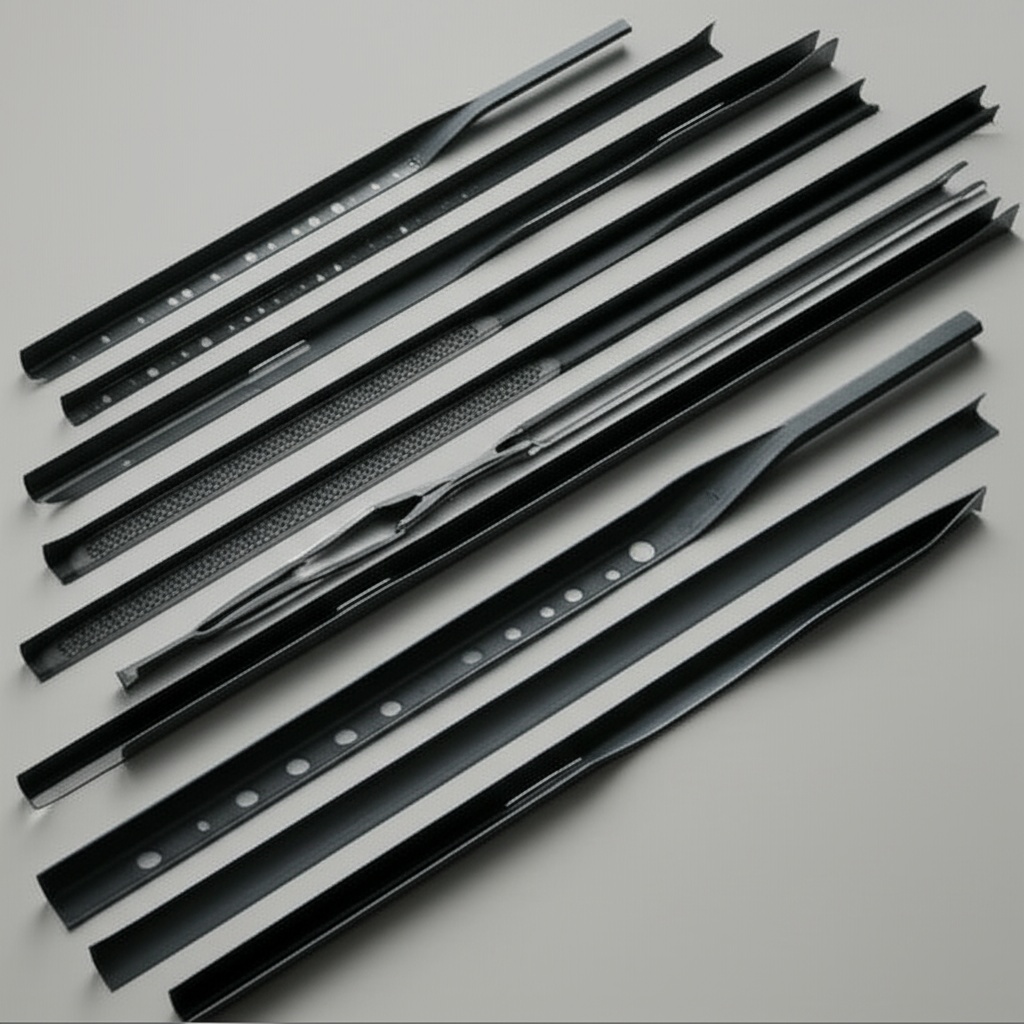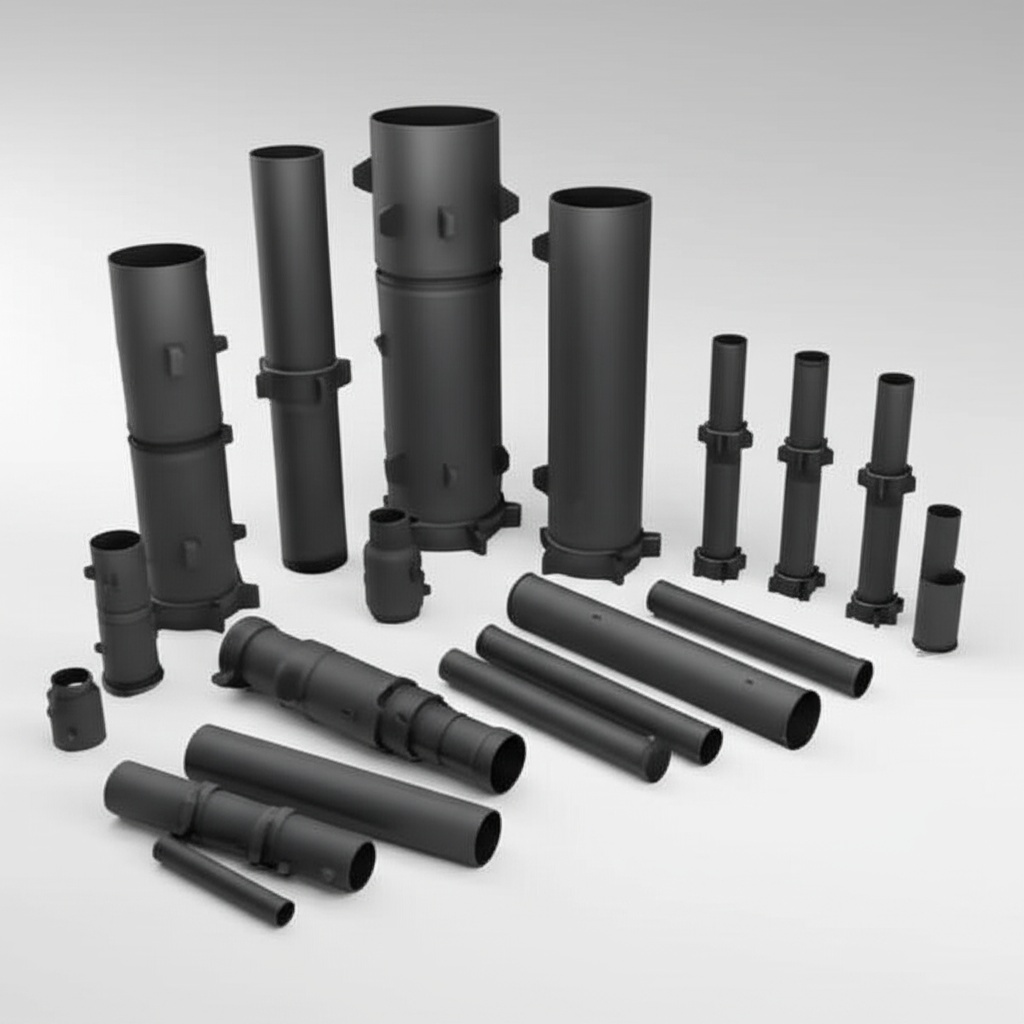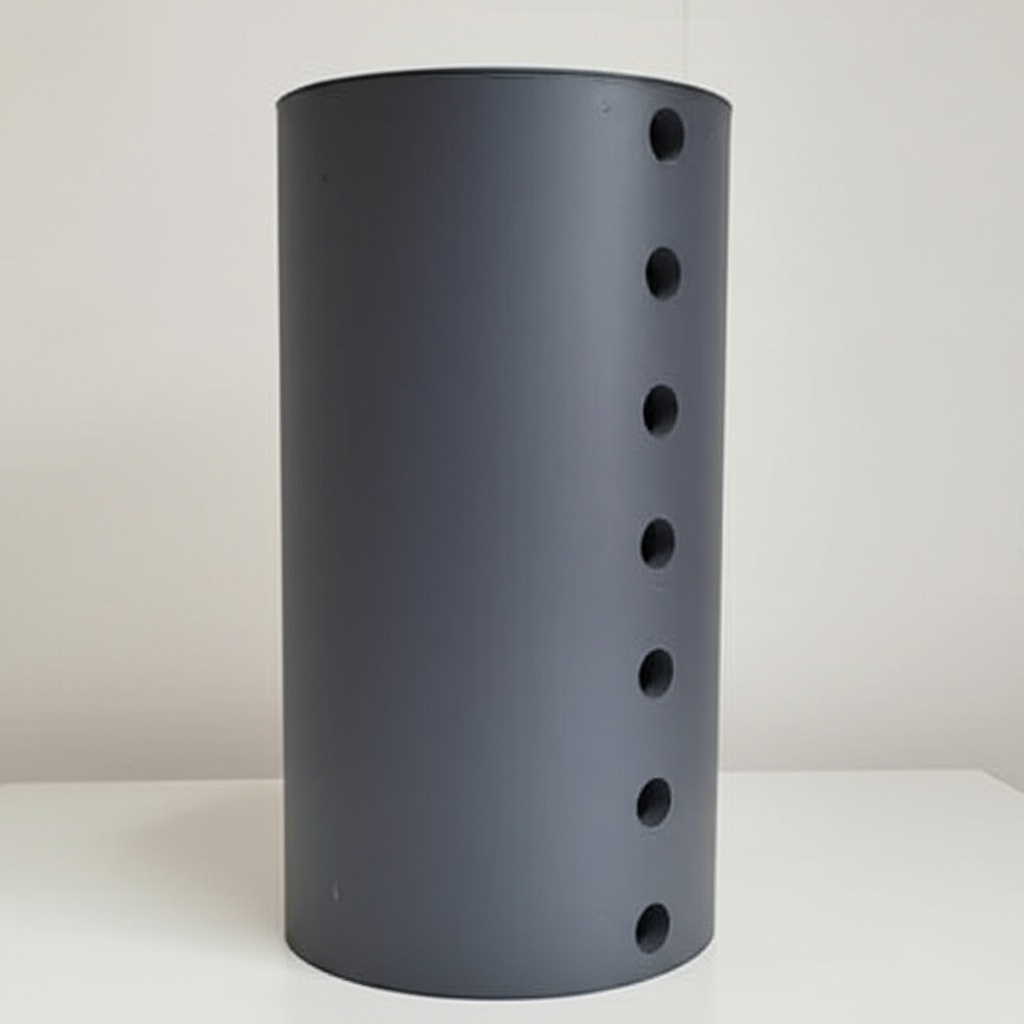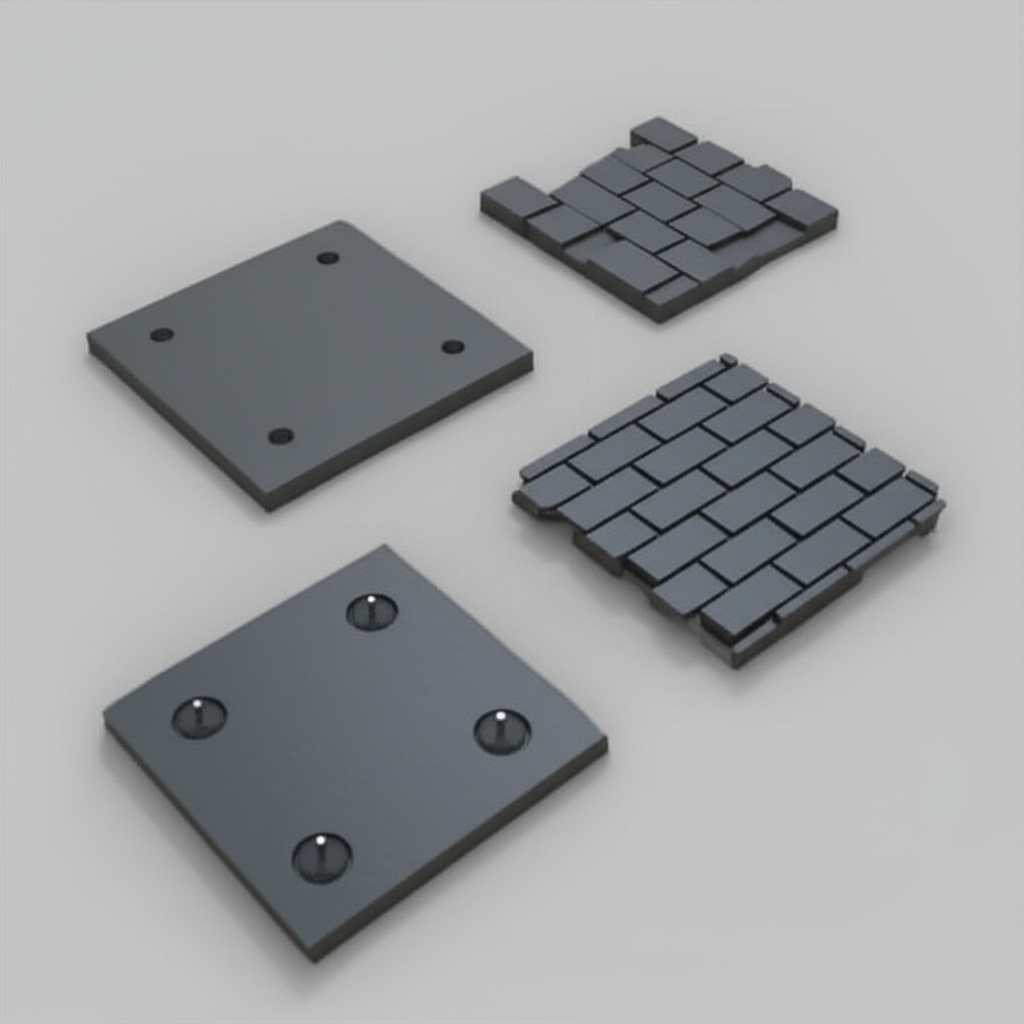SiC’s Growing Impact on the Automotive Industry

Share
SiC’s Growing Impact on the Automotive Industry
Introduction: SiC Accelerates Automotive Innovation
The automotive industry is undergoing its most significant transformation in a century. Electrification, autonomous driving, and enhanced connectivity are no longer futuristic concepts but rapidly evolving realities. At the heart of this revolution lies the need for advanced materials that can meet the stringent demands of modern vehicles. Silicon Carbide (SiC), a high-performance ceramic, is rapidly emerging as a critical enabler for this automotive evolution. Offering exceptional thermal conductivity, superior high-voltage switching capabilities, and remarkable wear resistance, SiC is not just an alternative material but a foundational technology driving efficiency, reliability, and performance in next-generation automotive systems. From electric vehicle (EV) powertrains to sophisticated sensor systems, the integration of custom silicon carbide components is paving the way for lighter, more powerful, and more resilient vehicles. This shift towards SiC is compelling for engineers, procurement managers, and technical buyers across semiconductor manufacturers, automotive companies, and their Tier 1 & 2 suppliers, who are all seeking a competitive edge in a rapidly evolving market. The unique properties of SiC directly address many of the inherent limitations found in traditional silicon-based components, particularly in high-power and high-temperature automotive environments.
The implications of SiC adoption are far-reaching, influencing everything from EV range and charging times to the durability of critical automotive parts. As the industry pushes the boundaries of innovation, the demand for high-quality, precisely engineered automotive SiC solutions will only continue to grow. This article delves into the expanding role of silicon carbide in the automotive sector, exploring its diverse applications, the benefits of customization, material considerations, design intricacies, and the crucial factors in selecting a knowledgeable SiC supplier for your demanding automotive projects.
Core Automotive Applications: Where SiC Drives Performance
Silicon Carbide’s unique combination of electrical and mechanical properties makes it exceptionally versatile for a wide array of automotive applications, particularly where high efficiency, power density, and reliability are paramount. Its impact is most profoundly felt in the rapidly expanding electric vehicle sector, but its benefits extend to traditional and hybrid vehicles as well.
Electric Vehicle (EV) Powertrains:
- Inverters: SiC-based inverters are a cornerstone of modern EV technology. They convert DC power from the battery to AC power for the electric motor. SiC MOSFETs (Metal-Oxide-Semiconductor Field-Effect Transistors) and diodes within these inverters offer significantly lower switching losses and higher operating frequencies compared to silicon IGBTs (Insulated-Gate Bipolar Transistors). This translates to:
- Increased inverter efficiency, leading to longer EV range for a given battery size.
- Higher power density, allowing for smaller, lighter, and more compact inverter designs.
- Improved thermal performance, reducing cooling system requirements and further saving weight and space.
- On-Board Chargers (OBCs): SiC components in OBCs enable faster charging times and higher efficiency. Their ability to handle higher voltages and temperatures means that OBCs can be made more compact and powerful, accommodating rapid charging standards without compromising performance or lifespan.
- DC-DC Converters: EVs utilize DC-DC converters to step down high voltage from the main battery to power auxiliary systems (e.g., infotainment, lighting, 12V systems). SiC-based converters achieve higher efficiency and power density, contributing to overall vehicle energy savings.
Charging Infrastructure:
Beyond the vehicle itself, SiC is crucial for developing high-power, fast-charging stations. SiC power modules in DC fast chargers allow for much higher power delivery (e.g., 350kW and beyond) with greater efficiency and reliability, reducing charging times significantly and making EV ownership more practical.
Advanced Driver-Assistance Systems (ADAS) and Autonomous Driving:
While power electronics are a primary driver, SiC’s mechanical properties are also valuable:
- Sensor Components: The stability and durability of SiC make it suitable for certain sensor housings or components that need to operate reliably in harsh under-hood conditions or exposed environments. Its thermal stability ensures consistent sensor performance across a wide temperature range.
- Precision Actuators: Components requiring high stiffness and dimensional stability can benefit from technical ceramics like SiC.
Braking Systems and Wear Components:
- High-Performance Brake Discs: Carbon-Ceramic brake discs, often incorporating SiC (e.g., Carbon Fiber Reinforced Silicon Carbide – C/SiC), offer exceptional fade resistance, lower weight, and longer life compared to traditional cast iron rotors. They are primarily used in high-performance sports cars and luxury vehicles but demonstrate the material’s potential.
- Bearings and Seals: For specialized applications requiring extreme wear resistance and high-temperature capability, industrial SiC bearings and seals can offer superior longevity and performance, potentially in areas like turbochargers or specialized pumps.
Thermal Management Systems:
SiC’s excellent thermal conductivity (often exceeding that of copper at elevated temperatures) makes it an ideal material for heat sinks and spreaders in power electronics modules and other heat-generating automotive components. Efficient thermal management is critical for the reliability and lifespan of these systems.
| Application Area | Key SiC Components | Primary Benefits |
|---|---|---|
| EV Inverters | SiC MOSFETs, SiC Diodes, SiC Power Modules | Higher efficiency, increased power density, reduced size/weight, improved thermal performance |
| EV On-Board Chargers (OBCs) | SiC Diodes, SiC MOSFETs | Faster charging, higher efficiency, compact design |
| EV DC-DC Converters | SiC MOSFETs, SiC Diodes | Higher efficiency, smaller footprint |
| Fast Charging Stations | SiC Power Modules | Higher power delivery, greater efficiency, improved reliability |
| High-Performance Brakes | C/SiC Brake Discs | Fade resistance, lower weight, longer life, superior high-temperature performance |
| Thermal Management | SiC Heat Sinks, Substrates | Excellent thermal conductivity, efficient heat dissipation |
The ongoing research and development in SiC materials science continue to unlock new potential applications within the automotive sector, promising further advancements in vehicle performance, safety, and sustainability.
The Strategic Advantage of Custom SiC for Automotive Manufacturers
While standard, off-the-shelf SiC components serve many purposes, the demanding and highly specific nature of the automotive industry often necessitates custom silicon carbide solutions. Automotive manufacturers and their suppliers gain significant strategic advantages by opting for tailored SiC parts, moving beyond generic offerings to achieve optimized performance, integration, and long-term reliability.
The key benefits of customization include:
- Optimized Performance for Specific Applications: Automotive systems operate under unique conditions – from the extreme temperature fluctuations under the hood to the high electrical stresses in EV powertrains. Custom SiC components can be designed with specific geometries, material compositions (e.g., tailored porosity or density), and surface finishes to maximize performance metrics like thermal dissipation, electrical insulation, wear resistance, or mechanical strength exactly where needed. For example, a custom-shaped SiC heat sink can be designed to perfectly fit a constrained space within a power module, maximizing contact area and cooling efficiency.
- Enhanced Integration and Packaging: Modern vehicles are marvels of compact engineering. Custom SiC parts can be engineered for seamless integration with surrounding components, reducing assembly complexity, minimizing system size and weight, and improving overall packaging efficiency. This is particularly crucial in EVs where space and weight are at a premium to maximize range and passenger comfort.
- Improved Thermal Management: The thermal properties of SiC are exceptional, but custom designs can further enhance heat dissipation. This might involve integrating cooling channels directly into a SiC component or optimizing its shape and surface area to interface more effectively with active or passive cooling systems. Effective thermal management is vital for the longevity and reliability of power electronics.
- Increased Reliability and Durability: By tailoring the SiC material grade (e.g., reaction-bonded SiC for complex shapes, sintered SiC for maximum density and strength) and design to withstand specific automotive stresses (mechanical shock, vibration, thermal cycling, chemical exposure), custom components can offer superior reliability and a longer operational lifespan. This reduces warranty claims and enhances brand reputation.
- Competitive Differentiation: In a fiercely competitive market, unique solutions offer a distinct advantage. Custom SiC components can enable proprietary designs that deliver superior performance characteristics (e.g., faster charging, longer range, more durable parts) that competitors using standard parts cannot easily replicate. This allows OEMs to highlight unique selling propositions.
- Supply Chain Security and Specificity: Working with a specialized SiC supplier for custom parts can lead to a more secure and tailored supply chain. The supplier understands the specific automotive requirements and can often provide dedicated production lines or processes, ensuring consistency and quality.
- Addressing Unique Challenges: Sometimes, an off-the-shelf component simply doesn’t exist for a novel automotive application or a particularly challenging engineering problem. Customization allows for the creation of entirely new SiC parts designed from the ground up to solve specific issues, fostering innovation.
Procurement managers and technical buyers should recognize that the initial investment in custom SiC development can lead to significant long-term benefits in terms of performance, reliability, and market leadership. Engaging with a supplier capable of understanding intricate automotive requirements and offering robust customizing support is paramount to leveraging these advantages.
Choosing Your Material: SiC Grades for Demanding Automotive Use
Not all silicon carbide is created equal. Different manufacturing processes result in various SiC grades with distinct properties, making material selection a critical step in designing automotive components. The choice of SiC grade directly impacts performance, manufacturability, and cost. Key grades relevant to the automotive industry include Reaction-Bonded Silicon Carbide (RBSC or SiSiC) and Sintered Silicon Carbide (SSC, typically SSiC or DDFSiC).
Reaction-Bonded Silicon Carbide (RBSC / SiSiC):
- Manufacturing Process: RBSC is produced by infiltrating a porous carbon preform (often made from SiC grains and carbon) with molten silicon. The silicon reacts with the carbon to form new SiC, which bonds the original SiC grains. This process typically results in a material containing some residual free silicon (usually 8-15%).
- Key Properties:
- Good thermal conductivity.
- Excellent thermal shock resistance due to the free silicon phase.
- High hardness and good wear resistance.
- Ability to produce complex, near-net-shape parts with relatively low shrinkage.
- Lower manufacturing temperatures compared to SSiC, potentially leading to lower costs for complex shapes.
- Automotive Applications:
- Structural components requiring good mechanical strength and thermal stability (e.g., supports, fixtures in high-temperature processing for automotive parts manufacturing).
- Wear parts such as seals, nozzles, and some types of bearings.
- Components where intricate designs are necessary and the presence of free silicon is not detrimental to the application (e.g., not ideal for extreme chemical environments that attack silicon).
- Kiln furniture used in the production of other automotive ceramic components.
Sintered Silicon Carbide (SSiC):
SSiC is produced by sintering fine SiC powder at very high temperatures (typically >2000°C), often with the aid of sintering additives (like boron and carbon for SSiC, or yttria/alumina for Liquid Phase Sintered SiC – LPSiC, also known as DDFSiC or Densely-Defined Formed SiC).
- Direct Sintered Silicon Carbide (SSiC – sometimes referred to as self-sintered SiC):
- Properties: Extremely high hardness, excellent wear resistance, superior chemical inertness (no free silicon), high strength even at elevated temperatures, good thermal conductivity. Generally offers the highest performance among SiC grades in aggressive environments.
- Automotive Applications: High-performance mechanical seals for pumps and drivetrains, advanced bearings, valve components, components for semiconductor manufacturing equipment (used to make automotive electronics), mirrors for LiDAR systems requiring high stability. Ideal for applications where purity and maximum corrosion/wear resistance are critical.
- Liquid Phase Sintered Silicon Carbide (LPSiC / DDFSiC):
- Properties: Achieves high density similar to SSiC. The liquid phase aids in densification, potentially allowing for lower sintering temperatures or different microstructures. Can offer very good mechanical properties and thermal conductivity. Surface finish capabilities can be excellent.
- Automotive Applications: Similar to SSiC, often chosen for its balance of properties and potential for achieving very smooth surfaces. Used in wear components, seals, and applications requiring high stiffness and thermal stability.
Other Notable SiC Types:
- Nitride-Bonded Silicon Carbide (NBSC): SiC grains bonded by a silicon nitride phase. Offers good thermal shock resistance and strength but generally not as high-performance as SSiC or RBSC for demanding wear or temperature applications. More common in metallurgical applications but could find niche uses.
- Chemical Vapor Deposited SiC (CVD-SiC): Produces ultra-high purity SiC. Used for semiconductor wafer processing equipment (which indirectly supports automotive electronics) and high-end optical components. Typically more expensive and used for specialized applications requiring extreme purity or specific optical properties.
| SiC Grade | Key Characteristics | Common Automotive Considerations | Relative Cost Factor |
|---|---|---|---|
| Reaction-Bonded SiC (RBSC) | Good thermal shock resistance, complex shapes feasible, contains free silicon. | Structural parts, wear components not exposed to aggressive chemicals attacking Si. | Moderate |
| Sintered SiC (SSiC) | Highest hardness, wear resistance, and chemical purity; excellent high-temperature strength. | High-performance seals, bearings, valve components, semiconductor processing parts. | High |
| Liquid Phase Sintered SiC (LPSiC/DDFSiC) | High density, good mechanical properties, excellent surface finish achievable. | Precision wear parts, seals, components requiring smooth surfaces and high stiffness. | High |
| Nitride-Bonded SiC (NBSC) | Good thermal shock resistance, moderate strength. | Less common in direct automotive parts, more for associated industrial processes. | Moderate |
Selecting the appropriate SiC material grade requires a thorough understanding of the application’s operational environment, performance requirements, and cost targets. Consultation with experienced SiC material scientists and application engineers is crucial for making an informed decision that ensures optimal component performance and longevity in demanding automotive systems.
Designing for Durability: SiC Component Engineering in Automotive
Silicon Carbide’s inherent material properties are outstanding, but realizing its full potential in automotive applications hinges on thoughtful component design and engineering. Unlike metals, SiC is a brittle ceramic, which necessitates specific considerations during the design phase to ensure manufacturability, durability, and optimal performance under demanding automotive conditions such as vibration, thermal cycling, and mechanical loads.
Key engineering considerations for automotive SiC components include:
- Managing Brittleness:
- Avoid Sharp Corners and Stress Concentrators: Generous radii and fillets should be incorporated into designs to distribute stress and prevent crack initiation. Sharp internal corners are major points of failure.
- Tensile Stress Minimization: SiC, like other ceramics, is significantly stronger in compression than in tension. Designs should aim to keep SiC components under compressive loads where possible or minimize tensile stresses through careful geometric design and load path management.
- Impact Resistance: While inherently hard, SiC can be susceptible to impact damage. Design considerations might involve protective housings, strategic placement within assemblies, or incorporating features that can absorb or deflect impact energy.
- Thermal Management Design:
- Thermal Expansion Mismatch: When SiC is interfaced with other materials (e.g., metals in an assembly), differences in coefficients of thermal expansion (CTE) must be carefully managed. This might involve using compliant interlayers, brazing alloys with graded CTEs, or mechanical designs that accommodate differential expansion without inducing stress.
- Optimizing Heat Dissipation: For thermal management components like heat sinks, the design must maximize surface area and ensure efficient thermal pathways. CFD (Computational Fluid Dynamics) analysis can be invaluable in optimizing shapes for airflow and heat transfer.
- Manufacturability (Design for Manufacturing – DfM):
- Complexity vs. Cost: While RBSC allows for complex shapes, overly intricate designs can still drive up tooling and manufacturing costs. Simplicity, where possible, is often more cost-effective.
- Wall Thickness and Aspect Ratios: Minimum and maximum wall thicknesses, as well as achievable aspect ratios, depend on the chosen SiC grade and manufacturing process (pressing, slip casting, extrusion, etc.). Designers must work within these constraints. Thin walls can be fragile, while overly thick sections can lead to issues during sintering or infiltration.
- Draft Angles: For pressed or molded parts, appropriate draft angles are necessary to facilitate easy removal from the mold.
- Joining and Assembly:
- Consider how the SiC component will be integrated into the larger automotive assembly. This might involve designing features for mechanical fastening (e.g., holes, though these need careful design to avoid stress concentration), brazing surfaces, or adhesive bonding.
- The choice of joining method will depend on the operating temperature, strength requirements, and chemical environment.
- Load Distribution:
- Ensure that mechanical loads are distributed as evenly as possible across the SiC component to avoid localized stress peaks. This might involve using compliant gaskets or ensuring flat and parallel mating surfaces.
- Lightweighting Opportunities:
- SiC is lighter than many traditional metals (e.g., steel). Designs should leverage this property where weight reduction is a goal (e.g., in EV components to improve range, or in rotating parts like brake discs to reduce unsprung mass). Topological optimization can help in designing stiff yet lightweight SiC structures.
- Prototyping and Iteration:
- Given the unique nature of ceramic design, an iterative approach involving prototyping and testing is often essential. This allows for design refinement and validation before committing to mass production. Finite Element Analysis (FEA) is a powerful tool to simulate stress distributions, thermal performance, and potential failure modes early in the design cycle.
Collaborating closely with an experienced technical ceramics supplier early in the design phase is crucial. Their expertise in SiC material behavior and manufacturing capabilities can guide automotive engineers in developing robust, reliable, and cost-effective components tailored for the challenging automotive environment.
Precision Matters: Tolerances and Finishing for Automotive SiC
In the high-stakes automotive world, precision is not just a goal; it’s a fundamental requirement. For silicon carbide components, achieving tight dimensional tolerances and specific surface finishes is critical for ensuring proper fit, optimal performance, and long-term reliability within intricate automotive assemblies. Whether it’s a SiC seal providing a critical barrier, a substrate for power electronics, or a precision wear part, its dimensional accuracy directly impacts the functionality of the entire system.
Understanding Achievable Tolerances:
The achievable tolerances for SiC components depend on several factors:
- SiC Grade: Different grades (RBSC, SSiC, LPSiC) have different shrinkage rates and behaviors during manufacturing, influencing the final dimensional control. Sintered grades typically experience more shrinkage than reaction-bonded ones.
- Manufacturing Process:
- Near-Net-Shape Forming: Processes like pressing, slip casting, and injection molding aim to produce parts close to their final dimensions (“as-fired” or “as-sintered”). Tolerances for as-sintered parts are generally wider. For RBSC, near-net-shape capability is a key advantage.
- Green Machining: Machining the SiC in its “green” (pre-sintered) state can improve dimensional control before final firing, but some distortion during sintering is still possible.
- Hard Machining (Grinding/Lapping): For the tightest tolerances, SiC components are typically diamond ground, lapped, or polished after sintering. This is the most precise method but adds to the cost.
- Part Complexity and Size: Larger and more complex geometries are generally harder to control to very tight tolerances.
Typical achievable tolerances for hard-machined SiC components can be in the range of micrometers (e.g., ±5 µm to ±25 µm or even tighter for critical features), but this requires specialized equipment and expertise. As-sintered tolerances might be closer to ±0.5% to ±2% of the dimension.
Surface Finish Options and Importance:
The required surface finish (Ra, roughness average) depends heavily on the application:
- Mechanical Seals and Bearings: These applications demand exceptionally smooth and flat surfaces (often sub-micron Ra values, sometimes in the nanometer range after polishing) to minimize friction, wear, and leakage. Lapping and polishing are essential.
- Substrates for Electronics: Smooth surfaces are needed for metallization and thin-film deposition. A controlled roughness might also be desired for adhesion.
- Optical Components (e.g., LiDAR mirrors): Require super-smooth, highly polished surfaces with specific flatness and reflectivity.
- Structural Components: May not require such fine finishes, and an as-sintered or ground surface might suffice, helping to control costs.
Achieving the desired surface finish involves processes like:
- Grinding: Using diamond wheels to remove material and achieve basic shape and dimension.
- Lapping: Using abrasive slurries on a flat plate to achieve very flat surfaces and fine finishes.
- Polishing: Using finer abrasives and specialized pads to achieve mirror-like finishes.
- Edge Treatment: Chamfering or radiusing edges can be important to prevent chipping in brittle SiC components.
Dimensional Accuracy and Its Impact:
- Fit and Assembly: Precise dimensions ensure that SiC parts fit correctly with mating components in an assembly, avoiding stress concentrations or loose fits that could lead to premature failure or underperformance.
- Performance Consistency: In applications like power electronics substrates, consistent thickness and flatness ensure uniform thermal and electrical performance. For seals, flatness directly impacts sealing efficiency.
- Reliability: Parts that meet dimensional specifications are less likely to experience unexpected stresses or wear patterns, contributing to overall system reliability.
Automotive engineers and procurement professionals must clearly define the required tolerances and surface finishes in their specifications. It’s crucial to specify only what is necessary, as overly tight, non-critical tolerances can significantly increase component cost without adding functional value. Working with a SiC manufacturer who has robust metrology capabilities and a proven track record in precision machining is vital for success in automotive applications.
Beyond the Mold: Post-Processing for Optimal Automotive SiC Function
Creating the basic shape of a silicon carbide component through forming and sintering (or reaction bonding) is often just the beginning. For many demanding automotive applications, various post-processing steps are essential to achieve the final desired properties, dimensions, surface characteristics, and overall performance. These secondary operations transform a near-net-shape part into a precision-engineered component ready for the rigors of the automotive environment.
Common post-processing needs for automotive SiC components include:
- Precision Grinding:
- Purpose: To achieve tight dimensional tolerances, precise geometries (flatness, parallelism, cylindricity), and improve surface finish beyond what’s possible with as-sintered parts.
- Method: Diamond grinding wheels are used due to SiC’s extreme hardness. Various grinding techniques (surface, cylindrical, centerless) are employed based on the part’s geometry.
- Automotive Relevance: Critical for components like bearing races, seal faces, valve seats, and precision shafts where exact dimensions and smooth surfaces are paramount for performance and longevity.
- Lapping and Polishing:
- Purpose: To achieve exceptionally smooth, flat, and often mirror-like surface finishes, significantly reducing surface roughness (Ra).
- Method: Lapping involves using a loose abrasive slurry between the SiC part and a lapping plate. Polishing uses finer abrasives on a polishing pad.
- Automotive Relevance: Essential for dynamic seal faces to ensure minimal leakage and low friction, substrates for semiconductor devices requiring ultra-smooth surfaces for thin film deposition, and optical components like mirrors for ADAS sensors.
- Edge Honing and Chamfering:
- Purpose: To remove sharp edges and corners, which can be points of stress concentration and prone to chipping in brittle ceramics like SiC.
- Method: Specialized grinding or honing tools are used to create small chamfers or radii on edges.
- Automotive Relevance: Improves handling safety and component durability, reducing the risk of fracture during assembly or operation. Particularly important for parts subject to mechanical shock or vibration.
- Cleaning and Surface Treatment:
- Purpose: To remove contaminants, machining residues, or surface oxides to prepare the component for subsequent steps like coating, bonding, or assembly.
- Method: May involve ultrasonic cleaning, chemical etching (with care, depending on SiC grade), or plasma treatments.
- Automotive Relevance: Crucial for ensuring good adhesion of metallization layers on SiC substrates for power electronics, or for preparing surfaces for brazing or adhesive bonding.
- Coatings (Less Common directly on structural SiC, more on associated parts or for sp

About the Author: Sicarb Tech
We provide clear and reliable insights into silicon carbide materials, component manufacturing, application technologies, and global market trends. Our content reflects industry expertise, practical experience, and a commitment to helping readers understand the evolving SiC landscape.




